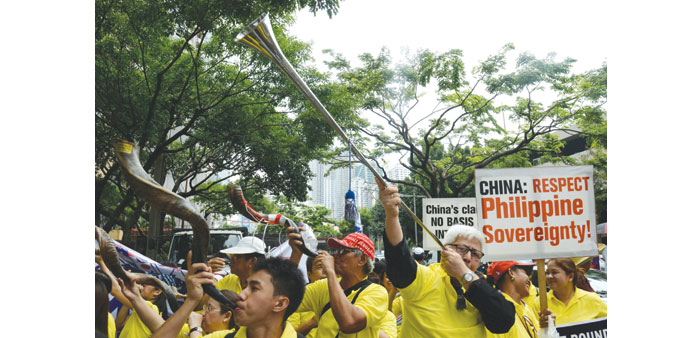Anti-China protesters blow horns during a protest in front of the Chinese consulate in the financial district of Manila.
Reuters/Manila
Philippine generals yesterday asked Congress to almost triple annual defence spending over the next five years to upgrade equipment amid an escalating marine dispute with giant neighbour China.
The Philippines currently is in the middle of a P998bn ($21.95bn) 15-year plan to modernise its armed forces in the face of rising tensions in the South China Sea.
“The gaps between our needed defence articles and the levels of our current inventory are too wide to ignore,” brigadier-general Guillermo Molina told a national defence panel hearing at the House of Representatives.
“As a way ahead, the Philippine Congress may want to consider pegging the defence annual budget to at least 2% of annual GDP.”
This year, Congress set aside P115.8bn, or less than 1% of GDP, for defence. Next year, the government has requested 129.1bnpesos. The military would need P308bn to get its desired 2% of GDP.
“Comparing the military spending of the Philippines with our neighbouring countries, the Philippines has one of the lowest spending levels,” Molina said, adding security was complicated by China’s occupation of Scarborough Shoal.
It was not immediately clear where the money would come from. Congressman Francisco Acedillo, a former air force pilot, said the house of representatives would have to study the military’s proposal.
“The figure is mind-boggling, but if our country needs that, we’ll have to find ways to support it,” he told Reuters.
China claims most of the potentially energy-rich South China Sea, through which $5tn in ship-borne trade passes every year, and rejects the rival claims of Vietnam, the Philippines, Brunei, Malaysia and Taiwan.
China seized control of the rocky Scarborough Shoal in 2012 after a three-month stand-off with Philippine coast guard ships, preventing Filipino fishermen from getting near their traditional fishing grounds.
Molina said Philippine air space was vulnerable to intrusions. The Philippines has no fighters or surveillance aircraft to detect and monitor activities within its vast maritime borders.
Molina said the navy had two former US coast guard cutters, three former British Royal Navy corvettes and Vietnam War and World War II-vintage patrol boats. It has a fleet of helicopters and several trainer jets and transport planes.
The military currently is seeking more than P520bn in the 15-year plan to 2022 to achieve a “full credible defence posture on the West Philippine Sea”, or South China Sea.



